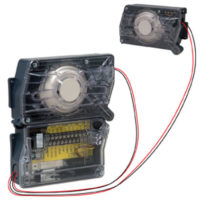For decades, fire professionals and systems designers have wrestled with the dilemma of which smoke detector to specify or use. One is better at detecting flaming fires, while the other is better at detecting smoldering fires.
The prevalent thinking is that most fire deaths occur in smoldering fires. Yet, according to a 2004 study by The National Institute of Standards and technology (NIST) titled, “Performance of Home Smoke Alarms,” 58% of the fire deaths occurred in what are labeled flaming fires. As a result of ambiguities like this, fire agencies like NFPA, the International Association of Fire Chiefs, Consumer Product Safety Commission, et al., recommend having protection against both types of fires. NFPA’s recommendation is “For the best protection, both (ionization and photoelectric) types of alarms or a combination alarm should be installed in homes.” This, of course, applies to any area where people live like dormitories, hospitals, hotels, etc.
Combination detectors are considered at times to be prohibitively expensive. So most choose: either ion detectors or photo detectors.
CURRENT STANDARDS AND TESTS
Current UL217 test protocols have two critical, determining fire tests: the flaming test and the smoldering test. Each of these was designed in the ’70s to have one test standard for all single-station detectors.
In 1974, when these tests were first considered, they were different than the tests now in use. The original flaming test used “…paper [that was needed to be] fluffed in such a way as to produce a sufficient volume of smoke before open flame took place.” Ignition was a match applied to the bottom center of a cylinder measuring 12 x 24 in. and made of 0.25-in. wire mesh.
This test did not reliably create enough visible smoke for photo detectors to detect, per the 1974 report, titled, “Large-scale Laboratory Fire Tests of Smoke Detectors,” by Dick Bukowski. So the test was modified. The wire mesh cylinder was replaced by a solid metal cylinder. This solid cylinder obviously restricted the air (oxygen) from reaching the burning paper ensuring that there was a lot of visible smoke to be detected. But is this truly a flaming fire?
The original smoldering fire used 2 lbs of cotton placed on a 1,000-W hot plate. Ionization detectors did not respond well to this type of smoldering fire, so in 1979, a new smoldering fire was adopted. It used Ponderosa pine sticks on a hot plate, with the temperature of the hot plate being increased over time. Seventy-five minutes were allowed for a detector to pass this test. By the end of the test, the Ponderosa sticks are red-hot embers giving off a lot of small particles.
There are many fires that smolder for hours, and there are many others that flame almost immediately. Once flame breaks out, either type of fire can flash over within minutes.
For years, manufacturers have been working hard to make detectors more responsive and less false alarm prone. For decades, some detector manufacturers have tried to get photo detectors to “see” smaller particles so they could detect flaming fires faster. At the same time, others have been trying to get ion detectors to sense larger particles. Neither attempt has had success until recently.
Ionization and photoelectric sensors emit an increasing signal during the development of a fire, usually in the form of a voltage change. But both wait for the signal to reach a predetermined level before going into alarm. And that is the way it has been for decades.
MICROPROCESSORS ARE GAME CHANGERS
In the ’80s, microprocessors were introduced into system detectors. This allowed detectors to be addressable. As time went on, more features were added through the capabilities of these microprocessors. A reset feature, by a control panel after a transient spike, was introduced. Signal smoothing and drift compensation were added. Later, adjusting the alarm point from the central control was included. All these features were intended to reduce false alarms.
LASERS ARE INTRODUCED
Detectors using lasers were developed because of the better control of false alarms in systems. This allowed for very sensitive detectors in the range of 0.01% obscuration (100 times more sensitive than photo detectors) that detect all fires much faster. But due to the increased false alarm potential, view detectors can only be used in benign and controlled environments. Aspiration detectors also began using lasers. But aspiration detectors are diluted due to sampling thereby increasing the real sensitivity. Both are very expensive, so neither can be used in most applications.
THE NEW TECHNOLOGY
The new technology works by monitoring the rate of change of the sensor’s signal over time. Then it acts very much like an electronic thermometer by determining the endpoint without taking the full amount of time to get there. Early glass-tube, mercury thermometers took minutes to give a reliable reading. Early electronic ones were faster but still took many seconds. Today, due to refinements in the algorithms used, an electronic thermometer can give a very accurate (to tenths of a degree) temperature within a few seconds. It is common practice and accurate.
This new technology uses a microprocessor, together with advance algorithms, to anticipate the reality of a smoldering fire. In simplest terms, it watches the increase of signal from the sensor, and if that signal is continuing to increase over a predetermined time (typically minutes), it will signal an alarm. Many signal processing techniques must be used in order to ensure reliable alarm notification.
An additional, and very important, benefit of the technology is that it is less prone to false alarms. This is because it can be set to a lower obscuration sensitivity (compared to its sister ion detector) while still detecting smoldering fires faster than a photo detector. Consequently, the technology can detect a smoldering fire much faster while being less sensitive. It is a trade-off – a little slower than it could be (while still faster than a photo) but in return, fewer false alarms.
This false alarm reduction was reported in a University of Maryland study, “Analysis of the Response of Smoke Detectors to Smoldering Fires and Nuisance Sources.” Their report states, “… (these) smoke alarms … have nominally equivalent nuisance alarm immunity to photo alarms in kitchen scenarios, and are more resistant … near bathrooms. … They are more resistant to nuisance alarms than all other smoke alarms utilizing an ionization sensor.”
QUESTIONS AND CONCERNS
Although some detectors on the market that use this technology are battery-operated while others are AC-operated with battery backup, there are no systems detectors using this technology yet. In addition, retail distribution is limited. Questions remain. How soon will authorities advocate for this new technology? How soon can manufacturers adopt this game-changing technology? When will specifiers write requirements for this type of detection capability? Will buyers and endusers look for this level of protection the next time? Will this open the door to a new standard for a higher-performing detector type determined by a more stringent test protocol?
Having a new tougher test protocol would give fire protection a new renaissance, one that provides significantly better protection, should reduce fire deaths, and has a reasonable cost. ES





